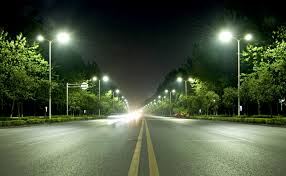LED streetlights have appeared in my village, one of the first pieces in the jigsaw which will depict a truly low carbon future, as seen from my doorstep.
They come not so long after the first electric car was spotted here. While electric cars are still a better-off person’s indulgence, that essential street light above your head is one of the most conspicuous things the council does for you. And you can’t object to the change, even if you are the most fervent climate denier. Because as well as saving a lot of carbon they are much cheaper to run, and repay the initial expenditure in a matter of a few years.
The county council (it is one of very many councils and municipalities around the world doing the same) approved a three year LED lighting replacement strategy across Buckinghamshire in June 2013. In all 7500 street lights will be replaced, mainly across the A & B road network. The new LED lanterns will be fitted on existing lamp posts.
The principal benefits from changing to LED technology are energy savings, lower carbon emissions and reduced maintenance costs compared with traditional units.
In a press release the council said LED lamps were now an established and reliable technology. They provide on average a 50-60% reduction to annual consumption over conventional sodium lights. Up to 80% is said to be achievable with the use of smart controls.
The new lights have a possible life of 20 years, compared to the standard 3 to 6 years for a traditional lamp. The LED lighting provides a clearer, brighter white light, compared to the traditional yellow glow of current street lights.
The press release notes that the cost benefits of switching to LEDs have increased considerably in the past year or so. Until 2013 the high price of fitting them largely cancelled out the benefits, except in larger projects where all of the units are replaced.
That has changed. Prices are now comparable to traditional lanterns and the case for fitting them is compelling. There has been opposition, however, from people living close to the lights will claim that white light disrupts sleep and may also disturb wildlife.
According to a council spokesman, unlike sodium lamps, they can be instantly turned on and off and can be dimmed. LED lights in Bucks are already being dimmed, he said, although the process of dimming is almost imperceptible to the naked eye. “They dim to 70% of their total light output between 22:00 and 06:00 and, in some areas, are dimmed even further to 50% of their total light output between 23:00 and 05:00.
Several thousand street lights have already been replaced in the county. The program to replace street lights in residential areas across the county is subject to future funding, but is already underway. The aim is to for 90% of street lights in the county to be LED within five years.
The Climate Group, an international non-profit organisation, said LED outdoor lighting also enhances public safety, minimizes light pollution and makes public spaces friendlier at night. In 2012 it called for all new street lighting to be LED, and all street lighting to be the same by 2020.
At the same time conventional traffic lights in Bucks are also being replaced with LEDs. The project is being funded through an interest-free financing scheme that supports technologies that achieve cost effective CO2 savings. With the estimated energy savings alone, this scheme should have paid for itself within six years.

